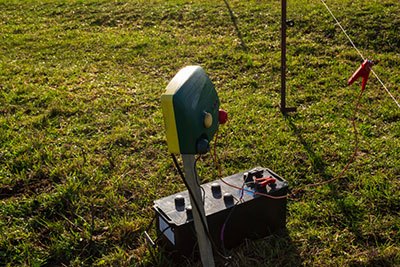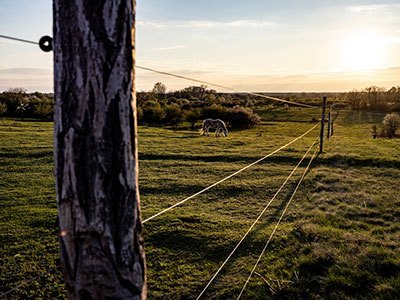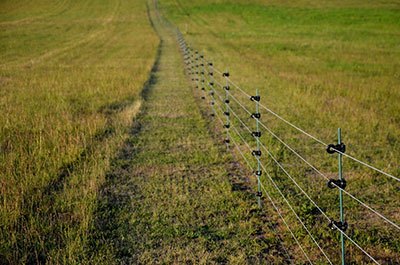Installing an electric fence around your property or backyard can be a smart investment if you’re looking for some extra security and peace of mind. It’s one of the most cost-effective ways to keep animals and intruders safely out while keeping your family safe inside.
This is why many homeowners find them such an attractive option when contemplating how best to safeguard their property from unwanted visitors!
In this blog post, we’ll walk through what kind of electric fencing options are available on the market today as well as provide readers with practical advice about the average electric fence costs associated with owning such a system in 2023.
Take away key points:
- Types of electric fences include wireless invisible fences, GPS invisible fences, invisible electric fences, above-ground electric fence, and portable and temporary electric fences that present a physical barrier to many wild animals and intruders.
- The typical price range and national average cost of electric fence installation depend on the electric signal, the entire property size and linear feet you want to cover, the use of specialty equipment, and labor costs.
- Wireless systems of electric fence typically cost more than regular electric fencing. However, the cost depends on how many pets you have.
Table of Contents
Factors that affect electric fence cost
1. Size of the area to be fenced
The more area you need to fence, the more materials you’ll need, which can increase the overall cost.
2. Type of animal to be contained

Different types of electric fences need to be installed based on the size and behavior of the animals you’re trying to contain. The type of fence that works for a group of cows may not be suitable for a group of goats or pigs.
If you are trying to contain dogs, then the wireless system is the best option for electric fencing. The pet wears a receiver collar that will keep the pet within the wireless perimeter.
3. Fence design and materials
Electric fences come in a range of designs, and the materials you choose can affect the cost. For example, a fence with wooden posts will be more expensive than one with steel posts.
4. Power supply
The power source for an electric fence can also have an impact on the cost. Solar charger– and battery-powered fences may be more expensive up front, but can be more cost-effective over time. The prices of solar chargers range from $100 to $500, and sometimes they can even go above $1,000.
If you opt for wireless fences, you need to make sure the connection is not interrupted.
5. Professional installation vs. DIY
If you hire a professional to install an electric fence, the cost will be higher than if you do it yourself. However, it may be worth the investment if you’re not comfortable with DIY installation or if you want to ensure that your fence is installed correctly.
Cost of electric fence installation by type
1. Permanent electric fences
Permanent electric fences or above-ground electric fence are designed for long-term use and typically require professional installation.
The cost of installation of above ground electric fence can vary depending on the type of fence, the size of the area, and the materials used. On average, the cost of installing a permanent electric fence can range from $1,500 to $3,000 per linear foot or more.
2. Temporary electric fences
Temporary electric fences are often used for short-term grazing or to contain animals during construction or other disruption of the typical grazing environment. These fences can be installed relatively easily and are usually less expensive than permanent electric fences, with installation costs ranging from $500 to $1,500 per linear foot.
3. Invisible electric fences

Invisible fences are a popular choice for pet owners who want to keep their dogs contained without a physical fence.
An invisible electric fence requires the installation of an underground wire and a collar that delivers a warning tone or mild shock to the dog when they approach the boundary. The cost of installation for an invisible fence typically ranges from $500 to $2,500 per linear foot.
When it comes to invisible electric fencing, there are a few types of systems available. Here’s an overview of the types of invisible fences and the average cost of installation:
– Underground wire fence: The most common type of invisible fence uses an underground wire that defines the circular boundary. If a dog gets too close to the boundary of the electric dog fence, a transmitter sends a signal to the wire, and the dog’s collar then emits a warning sound or a mild shock. The cost of installation for an underground wire fence or GPS invisible fence cost typically ranges from $800 to $2,500 per linear foot.
– Wireless electric fence: A wireless invisible electric fence uses a transmitter that emits a circular signal to create a therapeutic boundary around the property. A wireless fence can offer pet training for dogs and other animals. If the dog gets too close to the boundary, the collar it is wearing will sound a warning or give it a mild shock. The cost of installation for a wireless electric invisible fence typically ranges from $1,000 to $3,000 per linear foot.
– Hybrid electric fence: Hybrid invisible electric fence combine both underground wire and wireless technologies to create a more customizable and flexible system. This invisible fence have a higher initial cost, with installation typically ranging from $1,500 to $4,000 per linear foot, but they offer more features and can be tailored to your specific needs.
4. Portable electric fences
Portable electric fences are designed for use in situations where a temporary enclosure is necessary, such as on a farm or at a construction site. These fences are easy to install and can be moved around as needed. The cost of a portable electric fence system typically ranges from $200 to $1,000 per linear foot.
1. Electrical power
While electric fences are designed to use minimal amounts of electricity, the cost of electricity can add up over time. If you’re using a solar-powered or battery-powered electric fence, you may need to replace batteries or solar panels periodically, which can also add to the overall cost.
2. Fall and winter maintenance
If you reside in a region with harsh winters, you might need to take extra precautions to shield your electric fence from harm from snow, ice, and freezing temperatures. This can include removing snow and ice as it accumulates and storing battery-powered fence chargers somewhere warm and dry.
3. Pest control
In some cases, electric fences can actually attract pests like groundhogs, which can damage your fence and pose a threat to your animals. You may need to take extra steps to control pests and prevent damage to your electric fence.
4. Replacement parts
Over time, the components of your electric fence may wear out and need to be replaced. This can include insulators, tensioners, and grounding rods. Budgeting for replacement parts can help you avoid unexpected costs down the line.
DIY vs. Professional installation: which is more cost-effective?
1. DIY electric fence installation
Pros
– Typically less expensive upfront, as you don’t have to pay for professional labor costs.
– You have complete control over the installation process and can make changes or adjustments as necessary.
– Depending on your experience level, you may be able to complete the installation relatively quickly and easily.
Cons
– You may make mistakes during installation that result in added costs (e.g., buying the wrong materials, or not installing the fence properly)
– You may not have access to the same equipment or expertise as a professional installer, which could impact the quality of the installation and the longevity of the fence.
– You may need to purchase or rent specialized tools or equipment to complete the installation.
2. Professional electric fence installation

Pros
– More likely to result in a high-quality installation that is done correctly and efficiently.
– Professional installers have access to specialized tools and equipment that may not be available to DIYers
– You can typically receive a warranty or guarantee on the installation work.
Cons
– More expensive upfront due to the cost of professional labor
– Less control over the installation process, which could be an issue if you have specific needs or requests
– You may need to wait for an available installation appointment, which could delay the start of your project
Ultimately, the most cost-effective option for your electric fence installation will depend on your specific situation, your experience level, and your budget. While DIY installation may be less expensive upfront, it could end up costing more in the long run if mistakes are made.
However, while professional installation may be more expensive, it can give you peace of mind and help you avoid costly mistakes down the line.
How to save money on electric fence maintenance
1. Regular inspection and preventative maintenance
Inspecting your electric fence regularly (i.e., monthly or bi-monthly) can help you catch any issues early and prevent costly repairs down the line.
Check the wires, posts, insulators, and other components for damage, wear, and tear. Replace any damaged or worn parts before they cause bigger problems.
2. Proper grounding and earthing
Proper grounding and earthing are essential for the proper functioning of electric fences. Ensure that your grounding system is adequate and meets the manufacturer’s recommendations.
A poor grounding system can reduce the effectiveness of your fence, resulting in more energy usage and higher electricity bills.
3. Use the right charger
Choosing the right charger (i.e., energizer) for your electric fence is crucial. A charger that’s too small won’t be effective at keeping your animals contained, while one that’s too large can be costly and unnecessary.
Consider your specific needs when choosing a charger to avoid overspending or underbuying for your requirements.
4. Consider solar or battery power
If possible, consider using solar or battery-powered energizers instead of electric-powered ones. These options can save you money on electricity bills, especially if you have a large or remote property where running electricity can be expensive.
5. Address issues immediately
If you notice any issues with your electric fence, address them immediately. Small problems can quickly escalate into bigger and more costly issues if left unchecked. This can include replacing damaged wires, fixing insulators, or repairing a broken charger.
FAQs
Is an electric fence cheaper than a real fence?
An electric fence can be cheaper upfront than a real fence, but the cost of maintenance and upkeep may add up in the long run. Traditional fences are usually more expensive upfront but have lower ongoing maintenance costs.
Is an electric fence cheaper than wood?
Electric fences are typically less expensive upfront than wood fences. The cost of electric fencing can range from $1,000 to $6,000, while the cost of wood electric fencing can range from $5 to $30 per linear length.

How much electric fence do I need for 3 acres?
The amount of electric fence line you need for 3 acres will depend on a few factors, including the layout of your property and the type of animals you are containing.
However, a general guideline is to use approximately 1,320 feet of electric fence wire for every 2 acres of land. Based on this guideline, you would need approximately 1,980 feet of electric fence wire for 3 acres of land.
What is the disadvantage of an electric fence?
Electric fences have the potential to injure animals and humans, require a constant supply of electric power, require regular maintenance and upkeep, and may be subject to legal and liability concerns.
How much does an electric fence cost per month?
On average, the monthly electricity cost to power an electric fence can be between $10 and $50 per month. However, this is just the cost of electricity and does not include any additional maintenance or replacement costs.
Additionally, the electric fence costs depend on the type of electric fence line eg. invisible fence, above-ground electric fence..
How much for electric fence installation?
The cost of electric fence installation can vary based on factors such as the length of the fence, type of animals, terrain of land, and type of energizer.
On average, the cost can range from $1,000 to $6,000 or more for residential properties. It’s recommended to receive a detailed quote from a professional installer to get an accurate estimate.
Final words
Overall, the cost of installing an electric fence can vary based on a number of different factors. While electric fences can be cheaper upfront than traditional fences, they can have higher ongoing maintenance costs, including the cost of electricity usage and replacement parts.
Suppose you’re considering installing an electric fence. In that case, it’s important to work with a professional installer to get an accurate estimate of the cost and to ensure that your fence is installed correctly and safely.
